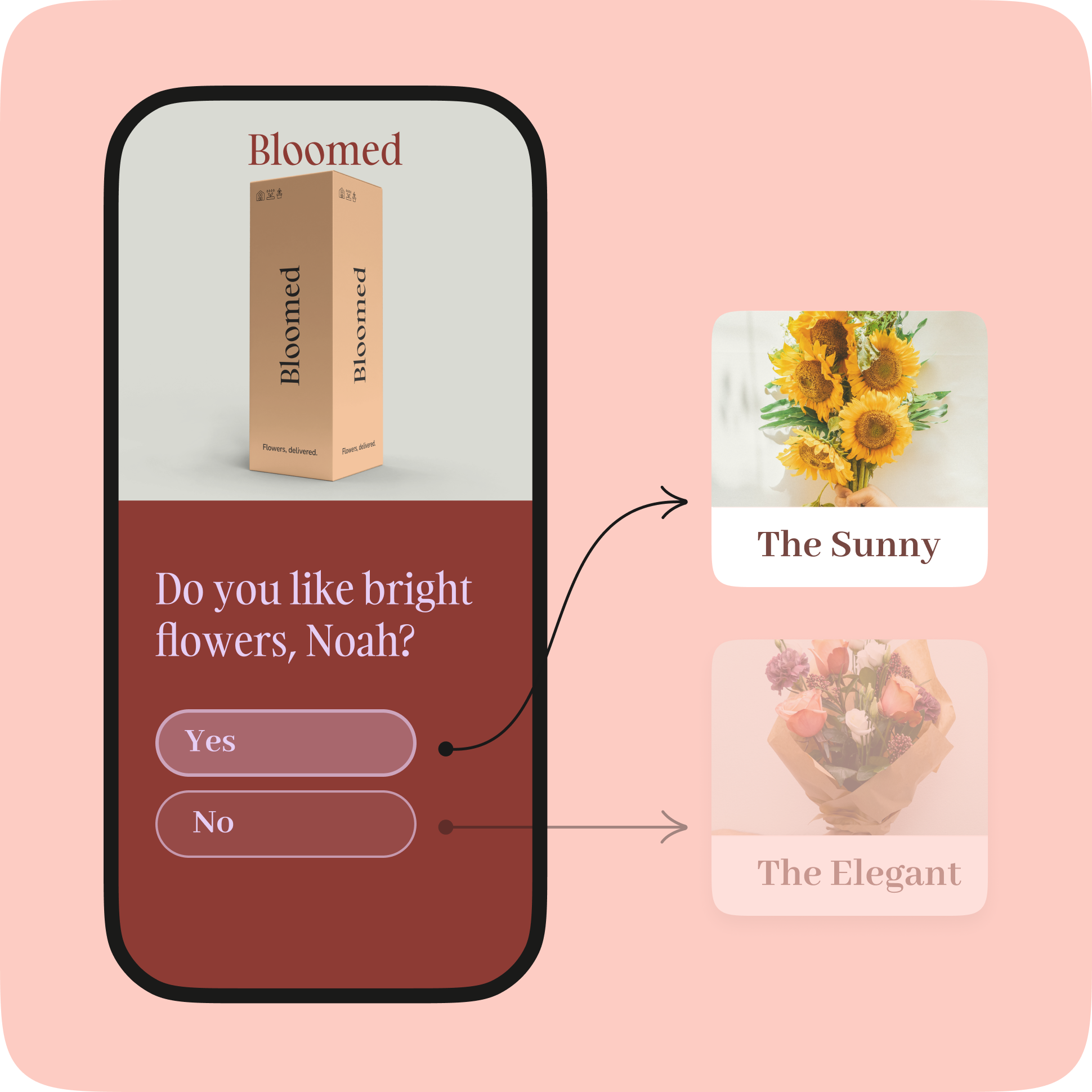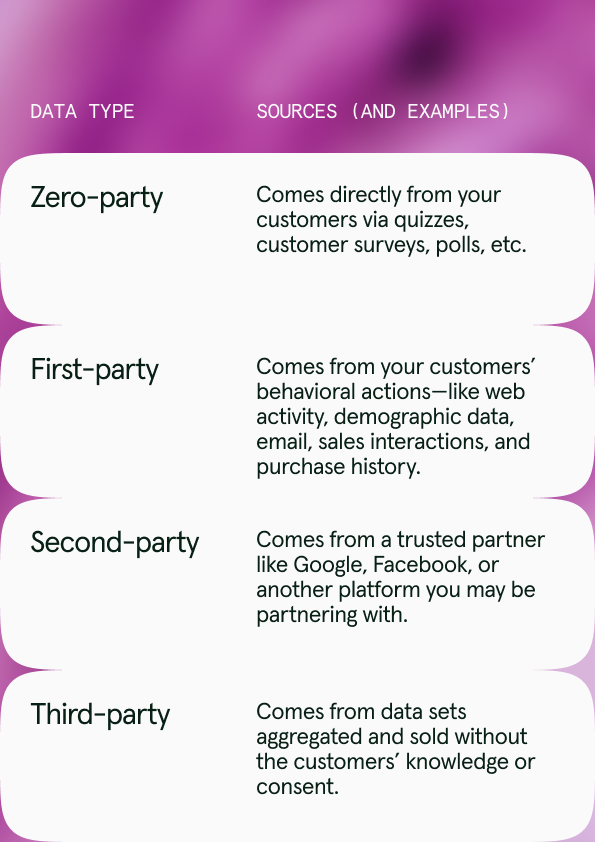Opinions and Expertise
The respectful marketer’s guide to marketing personalization
Consumers want both their privacy and personalization. So how exactly does the respectful marketer navigate this tightrope? Read on to learn how.

Between Amazon, Netflix, and Spotify—to name a few brands—we live in a world in which consumers now expect to receive personalized marketing suggestions. However, only 51% of customers trust brands to use their data responsibly and keep it secure.
Which means that, although personalization is now a consumer expectation, it’s also a source of consumer stress. There’s a privacy paradox that exists: Users want to receive personalized experiences, but they’re afraid to share their data to make these experiences possible. This is largely due to often-shady and soon-to-be-obsolete third-party tracking practices that have shaped consumers' online experiences.
With just a little effort, you can show your customers that you sympathize with their dilemma and show them respect. Discover why it' s important in marketing personalization, why you should care as a marketer, and four ways to show your customers a little personalization respect.
Why marketing personalization is necessary
Marketing personalization provides modern brands with a vehicle to actually reach their customers in an impactful way. Marketing personalization isn’t just “trendy,” it’s the future. And the future is here.
If brands want to remain relevant—or even noticed—in today’s oversaturated market, they have to provide real value for their customers. They have to build real relationships. Consumers are exposed to tens, hundreds, or even thousands of marketing messages per day, and personalization helps brands fight consumer apathy and marketing blindness.
It cuts through the noise
Distractions are everywhere in this ever-changing digital environment. Consumers become more informed and more connected by the minute. As recently as twenty years ago, people watched the news—predominantly on TV—and only if they caught it during one of two daily broadcasts. Consumers now live in a 24-hour news cycle where their phones can (and do) provide them with immediate updates at any moment.
To put today’s consumer power into perspective, consider this: The Guidance Computer used in the Apollo 11 mission—to put a human on the moon—had 12,250 Floating Point Operations Per Second (FLOPS), which is a measure of how many mathematical calculations a computer can perform within a second. Today’s iPhone has nearly 2.15 trillion FLOPS. And we have it connected to us at all times.
In 2023, the global B2C ecommerce market was valued at $4.8 trillion. Research suggests the market could reach $9 trillion by 2032. When hundreds of millions of brands are all vying for attention at the same time—and the market is only growing—marketers need to find a way to make themselves heard. Treating customers like individuals and personalizing their experience helps organizations do this.
It’s good for business
Personalization in marketing benefits both consumers and companies. According to McKinsey, marketing personalization can:
- Help brands reduce customer acquisition costs (CAC) by up to 50%
- Increase revenue by up to 15%
- Increase marketing ROI by up to 30%
Personalization not only drives sales but also increases customer loyalty. In fact, 56% of consumers say they' d buy from a brand again after receiving a personalized experience. And a growing number of businesses are recognizing the value of marketing personalization—69% of them are increasing their personalization investment, even during these uncertain economic times.
It provides a better customer experience
“One-size-fits-all” may work for beanies and baseball caps, but it definitely doesn’t work for marketing messaging. Creating custom experiences strengthens your consumers’ perception of your brand.
By providing each customer with a personalized experience, it helps to engage them. And engagement leads to a more satisfying consumer journey. Delivering tailored content, offers, and recommendations—within preferred communication channels at relevant times—shows your audience that your brand really cares about their needs.
The connections that marketing personalization helps you create won' t only be stronger, but more also meaningful. It helps your customers not only feel seen, but understood. Personalization shows your customers you see them as real people and not just numbers. However, the most pressing challenge with marketing personalization is collecting, analyzing, and using audience data without invading customer privacy.
Why marketers need to be careful about customer privacy
Marketing personalization isn’t possible without customer data. And customer data comes in four " forms" : zero-, first-, second-, and third-party data.
The law
Third-party cookies provide data to marketers that they can use to deliver customized and highly targeted ads directly to consumers, but marketers need to learn to live without them. They’re not only terrible for user privacy—they’re also becoming obsolete.
It’s in a company’s best interest to be upfront about the type of information they’re collecting from web visitors. There’s no federal law that requires “cookie consent” in the U.S., but most brands remain transparent about collecting them due to the California Consumer Privacy Act (CCPA). This law requires that consumers have the right to know the personal data companies collect and how it’s used, and it gives them the right to delete information or opt out of sharing it with other brands.
The General Data Protection Regulation (GDPR) was put into place to protect user privacy, promote transparency, and give consumers control over how their data is used. And because of laws like this, Mozilla Firefox, Apple iOS Safari, and soon Google Chrome will have done away with third-party cookies completely.
The ‘creepy’ factor
When consumers are served ads about products or services they’ve only spoken to close friends about or thought about in their own time, it makes them uneasy. Of course, they didn’t just speak or think about these products and services, but it feels like that to users due to third-party tracking cookies, which are considered the creepy ones. And although Chrome is completely getting rid of cookies this year, they’re still around for a little bit longer.
When third-party or even second-party cookies collect bits of consumer information from website visits, these sites sell or pass this information on to relevant companies or advertisers. And then, these companies or advertisers use the information to serve ads to their consumers.
And although consumers do have to consent to their data being collected, it’s not always obvious how this data will be used in the future. So it’s “creepy” when a seemingly unrelated marketing message pops up for users when they’re not expecting it.
Customer preferences
When 70% of internet users worldwide make efforts to protect their personal data, it’s important that brands take consumer privacy seriously. If companies want to make their customers feel respected, they need to clearly communicate their data intentions and give their users complete control of what they share. This may mean taking extra precautions to make sure visitors explicitly understand what they’re agreeing to.
By offering customers options for how, when, and to what extent they want to receive personalized content, you show them that your efforts are well-intentioned. Marketing personalization should enhance the consumer experience, not make them feel like they’re being watched.
4 ways to use marketing personalization respectfully
When brands personalize their marketing efforts for their customers, they need to prioritize consent and transparency. They should also seek to provide customers with something that incentivizes them to share their information, like a unique resource or something of monetary value.
Consumer data needs to be used ethically and without overstepping users’ personal boundaries. This means that even if you have the data, it may not always be the right choice to use it. But if you do use it, you need to make sure you’re doing it like a respectful marketer.
Address your customer naturally
Modern customers are sophisticated and more well-informed than ever, so using someone’s first name in a brand email isn’t necessarily going to set off any alarms. However, addressing customers unexpectedly could feel like the equivalent of cold-calling them.
When you personalize your customer’s marketing messages, make sure you’re speaking to them on the communication channels they prefer (and actually use). This means that some people will be more comfortable with social media messages or text over email. It’s worth it to look into this instead of just calling them out on all platforms and hoping for the best.
The best way to make sure you’re addressing your customers in a respectful way is by asking them directly to provide their preferred contact information. And then, when addressing them, make sure the content you’re providing is respectful to users’ time and attention and relevant to their preferences.
Make your recommendations specific
Of course, marketing personalization makes product and service recommendations possible, but make sure they’re actually recommendations—not wishes. Use your customers’ shopping history to offer complementary products and services based on things they’ve already purchased. Don’t just pitch random products with the hopes of making a sale. Remember, creating better customer experiences is key to personalization.
When you offer your customers things they’re actually interested in, you demonstrate that you understand them and value their attention. One way to reach customers more specifically is by segmenting them well. This means breaking down your customers into groups based on demographic, psychographic, and behavioral factors. The more direct data you have, the more granular your segmentation (and recommendations) can be.
Say it directly, and say less
When personalizing marketing messages, one of the most important considerations you can make is how your customers spend their time. People are often struggling to find ways to fit social outings and recreation into their schedules—they certainly don’t want to spend their precious moments reading lengthy marketing messages. Opt for direct language and brevity.
For example, if you have a conversational automated message that pops up on your website when a user navigates to the checkout page, try a simple “you might also be interested in” based on the items in their cart instead of a lengthy message about a suggested product’s uses and benefits. This isn’t to say you shouldn’t ever highlight your product’s uses and benefits because your customers will want to know this information, but the placement of your messages is also important. Save longer content for emails or send customers links to blog posts or product pages.
Provide real value
Your goal with marketing personalization isn' t just to make sales—it’s to build lasting relationships with your customers. And these relationships won’t last very long if you’re not providing any real value.
Trigger-based marketing messages can provide customers with offers that are relevant to their online activity and behavior. For example, if users complete a registration or form on your website, a trigger-based marketing message could pop up and offer them a discount for something they stated they were interested in.
Behavioral-based marketing messages can also provide users with value. For example, if a user has purchased luggage and a winter coat, offering them a coupon code for snow boots would be a lot more valuable than a code for swim trunks.
Offering personalized value doesn’t just increase the likelihood that your customers will convert immediately, it incentivizes them to come back for future purchases. And most importantly, it improves customers’ overall experience.
Collect zero-party data for more respectful personalization
If you collect zero-party data, or data that your customers offer up to you willingly, you can use it in your marketing personalization efforts confidently. Because this data comes directly from your exact customers, you also won’t have to worry about offending them or not fitting your target audience’s needs.
One way you can collect zero-party data is with on-site or emailed forms and surveys. You can also create product recommendation or personality quizzes to find out more about your customers in a way that’s fun, engaging, and helpful for them (and insightful for you).
The respectful marketer knows that marketing personalization is more than just putting someone’s name in an ad or bombarding people with sales pitches across the internet. Respectful marketers understand that the medium is equally as important as the message—and the message should be based on data collected ethically and transparently.







.png)
.png)